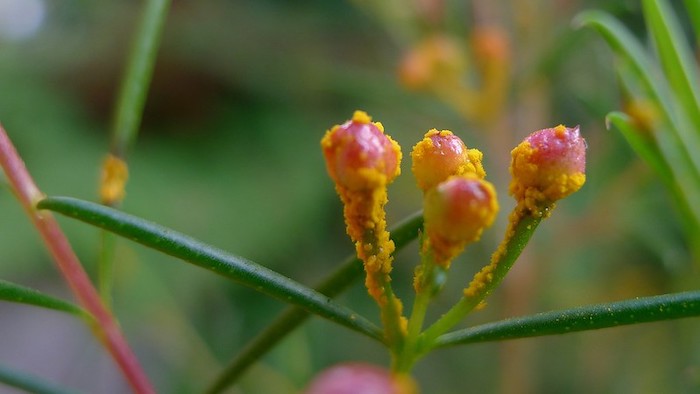Over 90 percent of the genome of this pathogen threatening Australian ecosystems is made of transposable elements.
Myrtle rust (Austropuccinia psidii) is a pathogenic fungus that has spread rapidly across the globe with devastating effects on local vegetation, including agricultural crops. It is extremely versatile, with over 480 known host species in the widespread myrtle (Myrtaceae) family. Researchers have prioritized studying myrtle rust in order to protect biodiversity, but these studies have been hindered by the lack of a complete reference genome—until now.
A study published in G3: Genes|Genomes|Genetics describes the assembly of the myrtle rust’s unusual genome sequence and reveals features that scientists hope will help them combat this destructive invasive species.
A. psidii has been particularly damaging in Australia, where Myrtaceae make up a large proportion of the native flora.
“Our dominant species in Australia are in the family Myrtaceae, so it was very alarming when we found we had this new disease that could potentially have a devastating impact on our ecosystems, as well as our forestry and other industries,” says Peri Tobias, PhD, one of the project’s principal investigators.
To sequence the A. psidii genome, a group of Australian researchers joined forces with scientists from New Zealand, where myrtle rust was first detected in 2017 and is now found across a wide area of the country.
A gigabase-sized undertaking
The team initially struggled to assemble the genome because early size predictions from previous studies were too small by nearly an order of magnitude. To determine the correct depth of coverage needed, Tobias and her team used flow cytometry and short-read analysis tests to estimate the fungus’s nucleus size and predict the size of the genome. The fungal nuclei predominate in a di-haploid state, and the researchers predicted that the haploid genome would be just over 1 Gb (gigabase), much larger than any previously assembled rust fungus genomes.
Building on this information, the researchers performed more long-read sequencing and mapped out scaffold grouping predictions based on the presence of telomeres. Assembling the A. psidii genome used a staggering 359,878 CPU hours, with the computations running continuously for over four months on the University of Sydney High Performance Computing Cluster. BUSCO (Benchmarking Universal Single-Copy Orthologs) confirmed that the assembled genome, which matched the prediction of ~1 Gb, was high-quality and over 94.7% complete.
Unique genomic features
The massive size of the A. psidii genome can be attributed almost entirely to repetitive regions that make up over 91% of the genome. Most of these regions are novel transposable elements that are unique to this species rather than being shared with other fungi.
In addition to the sheer number of transposable elements, the researchers were also surprised by the arrangements of repetitive regions within the genome. Rather than clustering together, most genes are quite spread out and interspersed with long non-coding regions; this suggests that some of the transposable elements may insert preferentially into intergenic regions rather than forming long stretches of repetitive non-coding DNA.
“We were quite gobsmacked by how much repetitive DNA was in there due to these transposable elements,” says Tobias. “It was very interesting to us because it seems to indicate high evolution potential in this fungus.”
Combating disease spread
The researchers believe this high evolution potential may have contributed to the fungus’s ability to infect such a wide range of hosts. To explore this hypothesis, Tobias and her colleagues are performing comparative studies between different strains of this pathogen. Future research will also focus on investigating the effector genes that manipulate host plants. Ultimately, understanding host-pathogen interactions will help the researchers uncover the characteristics that can make potential hosts resistant.
“When we’re looking at host-pathogen interactions, we’re always trying to find the mechanism by which the pathogen infects the host,” says Tobias. “Knowledge is power. Staying one step ahead of the pathogen, stacking resistance genes in our crops, working with the attributes that we know enable resistance—that’s how we’ll start to address these large problems.”
CITATION
Austropuccinia psidii, causing myrtle rust, has a gigabase-sized genome shaped by transposable elements
Peri A Tobias, Benjamin Schwessinger, Cecilia H Deng, Chen Wu, Chongmei Dong, Jana Sperschneider, Ashley Jones, Zhenyan Lou, Peng Zhang, Karanjeet Sandhu, Grant R Smith, Josquin Tibbits, David Chagné, Robert F Park
G3 Genes|Genomes|Genetics, Volume 11, Issue 3, March 2021, jkaa015, https://doi.org/10.1093/g3journal/jkaa015































